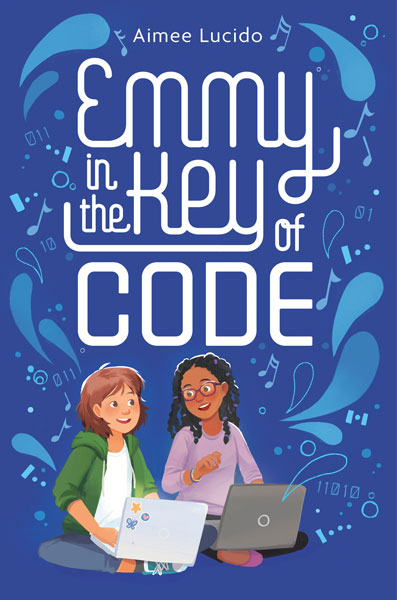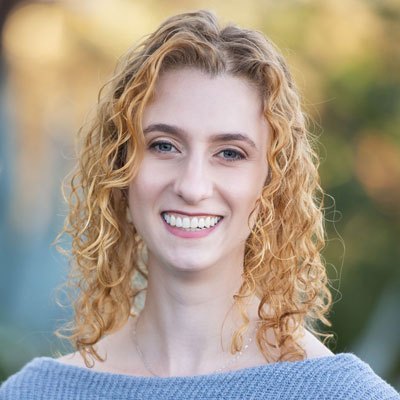We are so pleased to welcome Aimee Lucido to the blog! Aimee’s debut middle grade novel, Emmy in the Key of Code, came out in September 2019, from Versify. You can read our previous interview with Aimee in our Day-Job Connection series. And keep an eye out next week for a post on secondary characters in Emmy in the Key of Code.
Welcome, Aimee!
KidLit Craft: What do you love about writing middle grade novels?
Aimee Lucido: I love writing middle grade novels because of their focus on friendship. Middle school was tough for me, like it was for most of us, and in hindsight, I feel like a lot of that angst came from the shifting landscape of friendships that tends to happen around that age. Middle school is the time when people you’ve always been friends with stop liking you, or you stop liking them, or you realize you never truly liked them in the first place. It’s the time when people start figuring out what they’re “good” and “bad” at, and that starts determining what classes they take, what sports they practice, what instruments they learn, and all of that determines who they spend time with. And that’s an exciting time, because it’s when kids figure out who they are, but the effect it has on friendships is major, and that’s what draws me to writing about that time.
KLC: Can you talk a bit about how Emmy in the Key of Code evolved from early drafts to the final draft?
AL: In every story I write, I have at least one major change-up between first draft and final draft. Usually it involves a whole rewrite, sometimes it just involves a reframing, but it’s always something I feel in my gut long before I accept the fact that I need to change it. In the case of Emmy in the Key of Code, it didn’t involve a full rewrite, but it did involve deleting a thread that I had originally considered the heart of the story.
In both the final version of Emmy in the Key of Code, and the first draft, Emmy’s anxieties manifest through a nervous stomach. She has trouble eating, and often plays with her food when she’s worried about something. In the final version, this only pops up in a few anxious moments for Emmy, so it feels like a subtle and realistic character detail, but it never feels like a major plot point. And while this was always an aspect of Emmy’s character, it was a significantly more prominent detail in the first draft, due to when the book began.
When I started drafting Emmy, I didn’t want the story to begin on the first day of school because I knew it was a cliché. So, I decided to start it on the first day back from winter break. Everything else was the same: Emmy still had no friends, she was still feeling out of place at a new school, she was still worried she wasn’t a good musician, but the difference was, in the first draft, she had been feeling this way for four months at a new school instead of just for the first few days. This may not seem like a major difference, but because Emmy feels her anxieties in her stomach, this four-month-long feeling of not belonging had manifested itself as a vague eating disorder.
Eating disorders are heavy topics, and they are so hard to get right in fiction. And because the true heart of Emmy in the Key of Code was about belonging, the eating disorder thread was taking away from the story I wanted to tell. So, after many, many, many failed attempts to make that thread work, I cut it. Or rather, I moved the beginning of the book to the first day of school, which meant Emmy’s nervous stomach never would have had the chance to manifest as a full-blown eating disorder.
KLC: How has craft study informed your writing?
AL: This is an interesting question, because there’s the obvious answer and the non-obvious answer. The obvious answer is that craft study has helped me tremendously to make better books, and to hone my ear so that I know when something is working or not. I’ve become so much better at writing stronger characters with more compelling arcs, I can tell when my language is pitch-perfect and when it’s falling flat, I can revise more quickly than ever before, I can look at comp titles when I get stuck, I can pull from a wider range of craft techniques when I’m struggling to convey something . . . the list goes on and on. Learning craft has helped me become a better writer in countless ways, and I’m so grateful for that.

But there’s also a part of me that feels like craft study has made it harder to draft! Because I know when things aren’t working, and I find it so difficult to keep writing forward even when I feel the cracks in my existing work. Drafting has become very slow for me, but often my first draft isn’t really a first draft at all, it’s more of a fifth or sixth draft because of the number of times I’ve reworked the beginning based on things I know to be “wrong.” I need to be better at quieting down the part of me that has studied craft, that knows my language is broken, so I can actually finish a draft of a new project!
KLC: Your main character is easy to love. Can you offer some tips for how to build a relatable/lovable character?
AL: Well, first of all, I’m glad you think Emmy is easy to love! Especially because I feel like so much of my early feedback on my stories is that readers DON’T like my main characters. With Emmy, I realized readers didn’t connect with her because she was too passive. She was lonely at school, but wasn’t trying to do anything about it. She was just sad, sad, sad. That’s not fun to read, and that’s not someone you want to cheer for. I think a lovable character is someone who wants something and is trying with everything she has in her to go for it, but is failing no matter what she does. I think lovable characters are flawed, and make mistakes, but learn from those mistakes, and I think lovable characters love others. But as I’m typing this, I’m currently going back and forth with my editor for Recipe for Disaster (same editor as on Emmy) about how to make my main character in that book lovable. So, we’ll see how much I can take my own advice!
KLC: You write contemporary, but your book still feels as if it has strong world-building. What did you specifically do to give your readers a deep feeling of place in your novel?
AL: I once had a teacher who said that every author has one craft element they get “for free” and one craft element they “have to pay for.” My “free” craft element, I’ve always thought of as finding connections between seemingly unrelated things. But the technique I “have to pay for” has always been my setting. I don’t think about it when I read, I don’t think about it when I write, I don’t even really think about it when I go about my day-to-day life. Setting does not come easily to me AT ALL. So with Emmy in the Key of Code, as is common in my projects, setting became a late-stage revision addition. I knew it took place in San Francisco (although even that involved a bit of back-and-forth with my brain), so I decided to take some elements of my own life in San Francisco and inject them into the book. To me, those elements are weather and terrain.

San Francisco is known for its weird weather. For its microclimates and cold summers and foggy mornings. It’s very common for the beginning of fall to be chilly and miserable, and for the sun to only start to come out in late September, early October. When I was new to the city, this shocked me. So, I decided to give that same culture shock to Emmy. As a midwesterner, she’s not used to foggy summers, so when she starts to feel comfortable in her relationship with Abigail a few weeks into the school year, I had the weather mimic that: “October is when the sun starts to shine.”
I also tried to let Emmy’s relationship with the terrain of San Francisco mirror how she was feeling about being in a new place. Often newcomers to San Francisco are afraid of our hills. And with good reason: it’s hard to walk up them! But if you have to walk the same hills every day, you start to get used to them, and maybe even like them. So a big moment for Emmy comes when she realizes she’s not as out of breath on the hills as she once was. Her legs are building up muscle, and this city that once felt so foreign to her is quickly becoming home.
KLC: What was your biggest learning when you started working with an editor at a publishing house?
AL: I didn’t realize how much work goes into making a book LOOK like a book. My editor and I did about three rounds of revision on Emmy, but the bulk of the work on the project took place during pass pages [the actual pages of your book, laid out as they will appear when the book is bound]. Because the book [as a novel-in-verse] is formatted in such a specific way, when we changed the margins and font sizes from what I was using in my drafting process to what the final book would look like, the text became illegible. Tabbing was off, fonts were wacky, line breaks were missing, or misplaced, or multiplied by three. I’m not exaggerating when I say the book was impossible to read.
On top of that, code is hard to format. The book includes two different fonts, two different colors (visible in the e-book) and we assigned meaning to formatting decisions like italics and bold that had to be consistent throughout the book. And while we did have an incredible and patient copy editor on the project, when it came down to the specifics of how Java code had to look, that responsibility lay on my shoulders, because I was the one who had the list of (impossibly complex) rules in my head of what it needed to look like.
My editing team and I did a whopping TWELVE rounds of revision on the book, after the first round of copy edits. That’s right. TWELVE! I had no idea it could be so hard, but I’m also so proud of the way the final product turned out. I have yet to have anybody notice inconsistencies in the coding language, and I’ve had some real Java experts read it. So, I’m taking that as a win.
KLC: What one piece of advice would you like to give to aspiring middle-grade authors?
AL: Focus on the relationships. Friendships and familial relationships drive middle grade stories, and whenever I feel myself getting stuck on a project, it’s usually because the relationship isn’t front and center. If the main character isn’t relating to what’s going on–reacting in some way, or internalizing the scene–the content feels weak and passive. Make the main character respond to everything going on in the book, and the story immediately perks up.
KLC: What craft advice do you have for authors who want to write a novel in verse?
AL: Ultimately, a novel in verse is a novel in verse. People can get so bogged down in the verse part, and that’s important too, but at least for me, it helps to come in story-first. Plot, character, setting, theme, voice . . . it starts there, or you just have a bunch of pretty words in a Word document somewhere. The verse part, for me, comes in revision. The wordsmithing and the tweaking and the perfecting. But if the story doesn’t make sense, you don’t have much.
The other thing I would say is to be certain the story you’re telling should even be written in verse. With Emmy in the Key of Code, whenever I got stuck, I would return to the poetry, the music, the code in order to get unstuck. And it worked! But with my second book, Recipe for Disaster, I found that the poetic form was limiting. It was the thing making me stuck, not the thing unsticking me. So, it was a relief when Kwame [Alexander, of VERSIFY] sent me an email after reading the first 50 pages telling me he didn’t think the book was supposed to be in verse at all. It was meant to be a hybrid: poetry and prose. And he was right! The prose unlocks some scenes of the story in Recipe for Disaster, and the poetry unlocks others, just like code unlocked some scenes in Emmy in the Key of Code, and music unlocked others.
Now, I try to listen to the content when I’m trying to determine form. If a scene wants to be told in prose, I write it in prose. If it wants to be told in poetry, I write it in poetry. If it’s asking to be a recipe, or a block of Java code, or a comic, or an e-vite, or, I dunno, a pop-up ad, then I write it that way. Content dictates form. Always.
KLC: What new things are you trying craft-wise in your current WIP that you haven’t tried before?
AL: One thing I discovered late in my revision process for Emmy was how important it is to let our characters make mistakes. They can say rude things, they can feel hurt and lash out, they can hurt others and then immediately regret their actions–or not. Emmy only has one moment in the book where she truly regrets an action she took, but in Recipe for Disaster, I let Hannah, my protagonist, really screw up. I can think of at least four times off the top of my head that she does something she either immediately regrets, or learns to regret over the course of the book, and that’s a craft technique that I’ve only recently learned to wield.
Another thing I’m experimenting with in my newest works in progress is the comic form. This is currently popping up in two of my projects in different ways, and I can’t go much more into it than that, because these projects are SO new, but I am having fun thinking visually in that way.
KLC: What do you feel you’ve gained from being a part of the KidLitCraft community?
AL: The KidLitCraft community has become my social circle in the Bay Area. When I quit my job in tech, one of the things I was most worried about was missing my co-workers. I was used to going to an office, seeing the same people every day, and working alongside other people. But when I left, I was worried how losing human contact would influence my motivation and mental state. But the KidLitCraft community quickly became my “office.” We talk about the books we’re reading, the books we’re writing, and the stressors in our lives, both publishing-related and not. I’d be very lonely without them.

Aimee Lucido is the author of the upcoming novels EMMY IN THE KEY OF CODE (Versify, September 24, 2019), and RECIPE FOR DISASTER (Versify, Spring 2021). She has worked as a software engineer at Uber, Facebook, and Google, and she got her MFA in writing for children and young adults at Hamline University. She lives with her husband in San Francisco where she likes to bake, run marathons, and write crossword puzzles. Find her on Twitter @aimeelucido.
Anne-Marie Strohman (co-editor) writes picture books, middle grade novels, and young adult short stories and novels. She is trained as a teacher, an editor, and a scholar, specializing in Renaissance Literature. She holds an MFA in Writing for Children and Young Adults from Vermont College of Fine Arts and is an active member of SCBWI. Find her at amstrohman.com and on Twitter @amstrwriter.
COMMENTs:
0